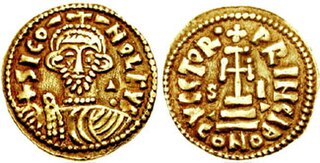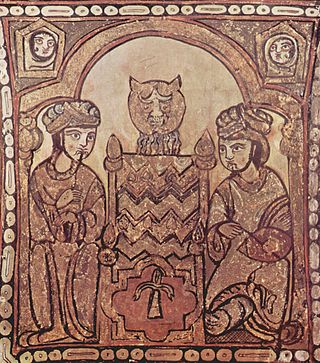The 830s decade ran from January 1, 830, to December 31, 839.

Year 839 (DCCCXXXIX) was a common year starting on Wednesday of the Julian calendar.

The history of Italy in the Middle Ages can be roughly defined as the time between the collapse of the Western Roman Empire and the Italian Renaissance. Late Antiquity in Italy lingered on into the 7th century under the Ostrogothic Kingdom and the Byzantine Empire under the Justinian dynasty, the Byzantine Papacy until the mid 8th century. The "Middle Ages" proper begin as the Byzantine Empire was weakening under the pressure of the Muslim conquests, and most of the Exarchate of Ravenna finally fell under Lombard rule in 751. From this period, former states that were part of the Exarchate and were not conquered by the Lombard Kingdom, such as the Duchy of Naples, became de facto independent states, having less and less interference from the Eastern Roman Empire.

The Duchy of Benevento was the southernmost Lombard duchy in the Italian Peninsula that was centred on Benevento, a city in Southern Italy. Lombard dukes ruled Benevento from 571 to 1077, when it was conquered by the Normans for four years before it was given to the Pope. Being cut off from the rest of the Lombard possessions by the papal Duchy of Rome, Benevento was practically independent from the start. Only during the reigns of Grimoald and the kings from Liutprand on was the duchy closely tied to the Kingdom of the Lombards. After the fall of the kingdom in 774, the duchy became the sole Lombard territory which continued to exist as a rump state, maintaining its de facto independence for nearly 300 years, although it was divided after 849. Benevento dwindled in size in the early 11th century, and was completely captured by the Norman Robert Guiscard in 1053.

The Duchy of Amalfi or the Republic of Amalfi was a de facto independent state centered on the Southern Italian city of Amalfi during the 10th and 11th centuries. The city and its territory were originally part of the larger ducatus Neapolitanus, governed by a patrician, but it extracted itself from Byzantine vassalage and first elected a duke in 958.

The Duchy of Naples began as a Byzantine province that was constituted in the seventh century, in the reduced coastal lands that the Lombards had not conquered during their invasion of Italy in the sixth century. It was governed by a military commander (dux), and rapidly became a de facto independent state, lasting more than five centuries during the Early and High Middle Ages. Naples remains a significant metropolitan city in present-day Italy.

The Duchy of Sorrento was a small peninsular duchy of the Early Middle Ages centred on the Italian city of Sorrento.

Siconulf was the first prince of Salerno, the brother of Sicard, prince of Benevento (832–839), who was assassinated by Radelchis. In response to Sicard's murder, the people of Salerno proclaimed Siconulf prince in opposition to Radelchis. At the time Radelchis was holding Siconulf prisoner in Taranto. A group of people from the cities of Salerno and Amalfi went there in disguise as Amalfian merchants and rescued Siconulf from prison, bringing him to Salerno.

Guaifer was the Prince of Salerno from 861. The son of Daufer the Mute and grandson of Daufer the Prophet, he was the first of the Dauferidi to sit on the Salernitan throne which his family dominated unobstructed until 977.
Radelchis I was the treasurer, then prince of Benevento from 839, when he assumed the throne upon the assassination of Sicard and imprisonment of Sicard's brother, Siconulf, to his death, though in his time the principality was divided.
Landulf I, called the Old, was the first gastald of Capua of his illustrious family, which would rule Capua until 1058. According to the Cronaca della dinastia di Capua, he ruled in Old Capua for twenty five years and four months and in New Capua for another year and eight months. According to Erchempert, he was "a very bellicose man".
Lando I was the count of Capua from 843. He was the eldest son and successor of Landulf the Old. Like his father, he supported Siconulf against Radelchis in the civil war dividing the Principality of Benevento in the 840s.

The Principality of Salerno was a medieval Southern Italian state, formed in 851 out of the Principality of Benevento after a decade-long civil war. It was centred on the port city of Salerno. Although it owed allegiance at its foundation to the Carolingian emperor, it was de facto independent throughout its history and alternated its allegiance between the Carolingians and their successors in the West and the Byzantine emperors in the east.

The Principality of Capua was a Lombard state centred on Capua in Southern Italy. Towards the end of the 10th century the Principality reached its apogee, occupying most of the Terra di Lavoro area. It was originally a gastaldate, then a county, within the principality of Salerno.
Andrew II was the duke of Naples from 834 to 840. During his reign, he was constantly at war with the Lombards and he allowed Gaeta, his vassal, to move towards independence under its own consuls.

The history of Islam in Sicily and southern Italy began with the first Arab settlement in Sicily, at Mazara, which was captured in 827. The subsequent rule of Sicily and Malta started in the 10th century. The Emirate of Sicily lasted from 831 until 1061, and controlled the whole island by 902. Though Sicily was the primary Muslim stronghold in Italy, some temporary footholds, the most substantial of which was the port city of Bari, were established on the mainland peninsula, especially in mainland southern Italy, though Muslim raids, mainly those of Muhammad I ibn al-Aghlab, reached as far north as Naples, Rome and the northern region of Piedmont. The Arab raids were part of a larger struggle for power in Italy and Europe, with Christian Byzantine, Frankish, Norman and local Italian forces also competing for control. Arabs were sometimes sought as allies by various Christian factions against other factions.

The Pactum Sicardi was a treaty signed on 4 July 836 between the Greek Duchy of Naples, including its satellite city-states of Sorrento and Amalfi, represented by Bishop John IV and Duke Andrew II, and the Lombard Prince of Benevento, Sicard. The treaty was an armistice ending a war between the Greek states and Benevento, during which the Byzantine Empire had not intervened on behalf of its subjects. It was supposed to last five years between the Lombard prince and the Neapolitans. It was a temporary armistice and was distinguished from other treaties such as Pactum Warmundi, which established temporary alliances.
Trofimena is a female saint canonised in the Roman Catholic Church. Originally from the town of Patti in Sicily, the relics of Trofimena are venerated in the basilica in the town of Minori, Italy on the coast of Amalfi, southern Italy.
Landulf of Conza, a Lombard nobleman, was briefly Prince of Benevento in 940 and then briefly Prince of Salerno in 973. The son of Atenulf II of Benevento, Landulf ruled on his father's death (940) as co-prince with his uncle, Landulf I, who soon sent him into exile. He initially took refuge at the court of Marinus II of Naples, from where he sought shelter in Salerno through his sister, Gaitelgrima, the second wife of Prince Guaimar II of Salerno. This he received and he was soon appointed gastald of Conza, while his sons—Landenulf, Landulf, Indulf, and Guaimar—were invested with land in Salerno. The Chronicon Salernitanum, which is the most important source for Landulf's life, names the counties of Marsi, Sarno, and Lauro as those of Guaimar, Indulf, and Landenulf, respectively, but does not name a county for Landulf.










